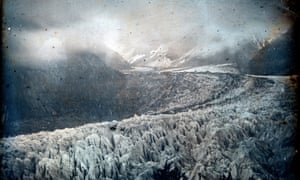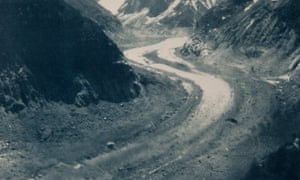New images by Emma Stibbon of locations used by Turner and Ruskin highlight the toll taken on Alpine landscape
A Royal Academician has followed in the footsteps of JMW Turner
and John Ruskin to capture in photographs the breathtaking sites in the
French Alps that 19th-century artists caught so strikingly. The
resulting images reveal a stark depiction of how climate change has
taken its toll on the glaciated landscape.
For a forthcoming exhibition on Ruskin and Turner, Emma Stibbon was commissioned to go to Chamonix and record the glaciers around Mont Blanc where, in the early 1800s, Turner painted sublime watercolours that inspired Ruskin to embark on his Alpine tours decades later, photographing and drawing awe-inspiring glaciers such as the Mer de Glace.
In June, the same month in which Ruskin produced his daguerreotypes (early photographs) of the Mer de Glace more than 160 years ago, Stibbon found his viewpoint for her own images, using another early photographic process, cyanotype. While Turner and Ruskin observed the drama of a sea of ice almost at the level they stood, Stibbon looked down into an exposed deep valley with “a dark moraine-covered floor, almost completely devoid of ice”. She saID: “It’s unrecognisable.”

For a forthcoming exhibition on Ruskin and Turner, Emma Stibbon was commissioned to go to Chamonix and record the glaciers around Mont Blanc where, in the early 1800s, Turner painted sublime watercolours that inspired Ruskin to embark on his Alpine tours decades later, photographing and drawing awe-inspiring glaciers such as the Mer de Glace.
In June, the same month in which Ruskin produced his daguerreotypes (early photographs) of the Mer de Glace more than 160 years ago, Stibbon found his viewpoint for her own images, using another early photographic process, cyanotype. While Turner and Ruskin observed the drama of a sea of ice almost at the level they stood, Stibbon looked down into an exposed deep valley with “a dark moraine-covered floor, almost completely devoid of ice”. She saID: “It’s unrecognisable.”

She added that Ruskin was ahead of his time in realising “the Industrial Revolution was affecting air quality and that air pollution was linked to the use of coal. He could see that glaciers move and I think he suspected that there was some [ice] recession, which would have been starting around that period in the 1850s.”
While Ruskin events extend to Japan and America, in the UK there is a cinema screening, from 22 February, of Effie Gray – the 2014 film written by Emma Thompson – and the exhibition, John Ruskin: The Power of Seeing, from 26 January at Two Temple Place, London. It features more than 190 exhibits revealing how Ruskin’s influence is still felt.
Robert Hewison, author of the recently published Ruskin and His Contemporaries, said: “Ruskin was, by the end of his life, treated as a kind of prophet – although not in his own country – for predicting both economic and ecological deterioration. Climate change appears to show that he was right.”

No comments:
Post a Comment